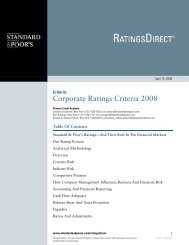European Infrastructure Finance Yearbook - Investing In Bonds ...
European Infrastructure Finance Yearbook - Investing In Bonds ...
European Infrastructure Finance Yearbook - Investing In Bonds ...
Create successful ePaper yourself
Turn your PDF publications into a flip-book with our unique Google optimized e-Paper software.
PROJECT FINANCE/PUBLIC-PRIVATE PARTNERSHIPS<br />
118 ■ NOVEMBER 2007<br />
and maintenance accounts, which are there to<br />
support the senior debt rating. Likewise, collateral<br />
security interests or claims upon liquidation<br />
granted to subordinate lenders should rank after<br />
senior debt.<br />
The maturity profile of subordinated debt<br />
should be longer dated than senior debt,<br />
otherwise it is not truly subordinated.<br />
The voting rights of debt participants.<br />
These rights should be limited solely to senior<br />
debt participants; subordinated debt should have<br />
no rights while senior debt is outstanding.<br />
Nonpetition language.<br />
This needs to be considered to ensure that no<br />
winding-up provisions are allowed while senior<br />
debt is outstanding either permanently or for a<br />
specified period. Typically, the objective is to<br />
ensure that subordinated debt has no right to<br />
challenge any enforcement rights or validity in the<br />
priority of payments of senior debt holders.<br />
The events of default and termination events<br />
of any interest-rate swaps used to hedge<br />
subordinated debt.<br />
These need to be closely examined. Although the<br />
majority of subordinated debt is fixed-rate debt, if<br />
variable subordinated debt is used and overlaid<br />
and mitigated with a interest-rate hedge, the<br />
events of default and termination events of the<br />
swap would need to be limited so as not to<br />
accelerate or cross-default senior debt.<br />
Subordinated debt rights or remedies in a<br />
restructuring, insolvency, or<br />
bankruptcy proceeding.<br />
Deeply subordinated debt should not have any<br />
such rights or remedies. For beneficial equity<br />
treatment, project subordinated debt should only<br />
be able to enforce its security and creditor rights<br />
unless, and until, senior debt has done so.<br />
What is the analytical framework for project<br />
subordinated debt?<br />
Some market participants think of the analytical<br />
assessment behind rating subordinated debt as<br />
one of simply solving a target debt-service cover<br />
ratio (DSCR) or simply notching off the senior<br />
debt issue rating. But our approach is more<br />
sophisticated. No two projects are the same from<br />
STANDARD & POOR’S EUROPEAN INFRASTRUCTURE FINANCE YEARBOOK<br />
a business, industry, market, operational,<br />
structural, or legal perspective. Certainly, it is fair<br />
to say that a senior debt issue rating provides<br />
some starting point for the subordinated debt<br />
rating. However, in order to make a proper<br />
assessment, we assess a project’s cash flows to<br />
understand where the credit stress points may be<br />
relative to the payment structure under the<br />
subordinated debt instrument and its exposure<br />
horizon. <strong>In</strong> assessing the ability and willingness of<br />
a project’s subordinated debt to pay its<br />
obligations in full and on time, our analytical<br />
framework reviews and measures a number of<br />
elements that influence the level of potential<br />
default and rating of a subordinated debt tranche:<br />
The underlying business and industry risk of<br />
a project.<br />
This examines the key business and industry<br />
economic fundamentals that influence the<br />
underlying volatility of a project’s operating cash<br />
flow.<br />
A project’s financial ratios (for example, DSCR<br />
on a total debt basis {senior and subordinated<br />
debt} and segregated subordinated debt basis after<br />
{senior debt}). It is important to note that the<br />
DSCR should not be viewed in isolation. This is<br />
particularly true when a project includes accreting<br />
debt structures that can overstate a transaction’s<br />
DSCR, while also deferring senior debt<br />
amortization. (see “Accreting Debt Obligations<br />
And The Road To <strong>In</strong>vestment Grade For<br />
<strong><strong>In</strong>frastructure</strong> Concessions” on page 105). As a<br />
result, we closely examine all financial ratios,<br />
particularly revenue growth assumptions and the<br />
components of the coverage ratios that are can be<br />
overstated by such financing instruments.<br />
Senior debt cash lock-up triggers, sweep triggers,<br />
and reserve limits (for example, senior debtservice<br />
reserve and maintenance reserves).<br />
Understanding these triggers and reserves is a<br />
critical part of the analytical framework for<br />
subordinated debt, as such lock-up triggers and<br />
reserves are for the protection of senior lenders<br />
only, and may result in subordinated debt being<br />
more susceptible to default, particularly if<br />
subordinated debt does not have its own<br />
dedicated debt-service or liquidity reserve.



